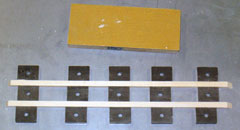How
to Build Warren Truss Fuselage Sides
The second best fuselages possible for flying model aircraft are
built using
Warren truss construction. This type of construction is also
commonly used for flying surfaces.
The best fuselage is built of stringers or skins over round formers which results in
an airplane that has better aerodynamics, is more attractive and,
unfortunately, is exponentially more difficult
to construct.
Most modern sport models have laser-cut
balsa
wood or
lite plywood fuselage
sides. Lite ply sides are about the worst type ever conceived.
Lite ply has extremely poor strength-to-weight. The only thing
lite ply sides have going for them is that they're already "built" and
are very cheap to
manufacturer.
The fundamental truth is that you will never have a model aircraft
that lives up to its potential until you're willing to do the work.
ARF's are always over-weight and kits usually include poorly selected wood
that is heavier than necessary. Kits can be corrected by replacing
wood as needed, but that means cutting new parts which somewhat negates the
virtues of building a kit in the first place.
Trussed fuselage construction was very common in days of old. Many
people who have entered the hobby in the last 20 years have never
built a set of fuselage sides such as these. I haven't conducted any
polls, but I suspect most of these builders believe that trussed sides are too
difficult or take too long to build.
I concede that trussed construction is more time-consuming to build than a slab of wood that's
pre-cut, but that's the only disadvantage. In other realms, trussed
fuselage sides are far superior to solid sides. Trusses have a high strength-to-weight ratio, are extremely rigid and are very light.
These are the most desirable properties for any airframe other than being
straight which is dependent on the builder, not the construction materials or engineering.
How to Earn Bonus Points
When well done, truss construction has a functional beauty that
is aesthetically pleasing under transparent and translucent coverings. If you look at
bridges and marvel at the engineering then you know what I'm talking about.
-
 Always
sand everything. That means all sides of every stick, the faces
of all formers, the inside and outside of the fuselage sides and every other part
in the airframe.
Sanding
is something that anyone can do and the appearance of your model will improve
tremendously. Always
sand everything. That means all sides of every stick, the faces
of all formers, the inside and outside of the fuselage sides and every other part
in the airframe.
Sanding
is something that anyone can do and the appearance of your model will improve
tremendously.
Tip! When sanding sticks, space
them slightly apart on your bench and
block sand two or more at a time.
This method helps prevent rounding over thin edges unintentionally.
-
Do not use
CA because there is no way to control where it goes and it makes a
really ugly mess.
Use
Carpenter's glue instead. Cut a bevel on the end of the
toothpick or bamboo skewer to make a scooper to remove excess glue. If you do this
then no glue will be visible in your wood work and everyone at the field
will hold your superior craftsmanship in awe.
This tutorial will take you step-by-step through the process and demonstrate
how to build Warren truss structures such as fuselages and control surfaces. One
fuselage side can be built in just a few hours. You
should easily be able to complete both sides in a single day or at most one
weekend while still having time to accomplish something else important like
watching TV.
|
![]()